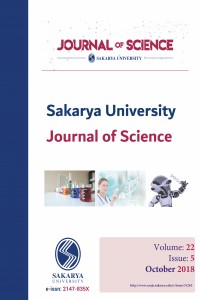Abstract
Keywords
References
- [1] Stanton, D,E., ''The expansion of concrete through reaction between cement and aggregate,'' Proc. Amerikan Society of Civil Engineers, 66:1781-1881, 1940.
- [2] Figg, J., ''ASR-Inside Phenomena and Outside Effects (Crack Origin and Pattern),'' pp.152-156, P.E.Grattan- Bellew (Ed.), Concrete Aggregate Reaction Noyes Publications, NewJersey, 509p, 1987.
- [3] Poole, A.B., ''Introduction to Alkali- Aggregate Reaction in Concrete,'' pp.30-53 The Alkali Silica Reaction ,n Concrete, R.N. Swamy (editör) Van Nostrand Reinhold, Newyork, 1992.
- [4] Swamy, R.N., ''Testing for Alkali Silica Reaction,'' pp.54-95, The Alkali-Silica Reaction in Concrete, R. N. Swamy (editor), Van Nostrand Reinhold, New York, 1992.
- [5] Yıldırım, K., Sümer, M., Uysal, M., '' The Optimization of Mineral Admixture Compositions in Reducing Concrete Alkali Silica Reactions'' Unpublished PhD Thesis, 2013.
- [6] Lewis, R., Sear, L., Wainwright, P. and Ryle, R., '' Cementitious Additions,'' Advanced Concrete Technology Set, V.3, Butterworth&Heinemann, 2003.
- [7] Tokyay, M., ''Betonda UK, GYFC ve SD'nin Rolü,'' Beton 2013 Hazır Beton Kongresi, pp. 201-238, 2013 [8] ASTM C-289-94, “Standard Test Method for Potential Reactivity of Aggregates (Chemical Method)”, Annual Book of ASTM Standards, Annual Book of ASTM Standards, Concrete and Aggregates, Philadelphia, PA, USA, American Society for Testing and Materials, 4 (2): 157-163, 1994.
- [9] TS 2517, ‘’Chemical Test for Potential Reactivity of Alkali Aggregates’’, Turkish Standards Institute, Ankara, 1977.
- [10] Yıldırım K, Sumer M., ‘’Comparative Analysis of Fly Ash Effect with three Different Method in Mortars that are Exposed to Alkali Silica Reaction’’, Composites: Part B, 2013.
- [11] ASTM C-227-97,“Standard Test Method for Potential Alkali Reactivity of Cement-Aggregate Combinations (Mortar-Bar Method)”, Annual Book of ASTM Standards, Concrete and Mineral Aggregates, Philadelphia, PA, USA, American Society for Testing and Materials, 4 (2): 126-130, 1994.
- [12] ASTM C-1260-94,“Standard Test Method for Potential Alkali Reactivity of Aggregates (Mortar-Bar Method)”, Annual Book of ASTM Standards, Concrete and Aggregates, Philadelphia, PA, USA, American Society for Testing and Materials, 4 (2): 650-653, 1994.
- [13] Statistical Package for the Social Sciences (SPSS) SPSS 18
Abstract
Presence of alkali silica in aggregates that are used in concrete production causes formation of cracks and
decrease of performance over time in concrete.The first damage caused by ASR in Turkey had been
observed in certain highway bridges in Izmir locality in 1995. It was found that some aggregates in other
regions of Turkey also have a character to cause ASR.The purpose of the study was to minimize potential
alkali silica reaction expansion in concrete and mortars produced with the aggregates that are used in
constructions in our region.Accelerated mortar bar test method was employed in the study. It was
observed in experimental study that that the use of 20-25% fly ash, 25-35% blast furnace slag and 10%
silica fume and metakaolin as mineral additive reduced ASR.According to optimization studies, it is
appropriate to use 5-10% silica fume, 5% metakaolin, 10-15% blast furnace slag and 10-20% fly ash as
mineral additive in optimum mixtures giving ideal expansion value.It was found that the use of 65% of
cement together with 35% silica fume, metakaolin, blast furnace slag and fly ash in mineral additive
combinations prevents ASR.
Keywords
References
- [1] Stanton, D,E., ''The expansion of concrete through reaction between cement and aggregate,'' Proc. Amerikan Society of Civil Engineers, 66:1781-1881, 1940.
- [2] Figg, J., ''ASR-Inside Phenomena and Outside Effects (Crack Origin and Pattern),'' pp.152-156, P.E.Grattan- Bellew (Ed.), Concrete Aggregate Reaction Noyes Publications, NewJersey, 509p, 1987.
- [3] Poole, A.B., ''Introduction to Alkali- Aggregate Reaction in Concrete,'' pp.30-53 The Alkali Silica Reaction ,n Concrete, R.N. Swamy (editör) Van Nostrand Reinhold, Newyork, 1992.
- [4] Swamy, R.N., ''Testing for Alkali Silica Reaction,'' pp.54-95, The Alkali-Silica Reaction in Concrete, R. N. Swamy (editor), Van Nostrand Reinhold, New York, 1992.
- [5] Yıldırım, K., Sümer, M., Uysal, M., '' The Optimization of Mineral Admixture Compositions in Reducing Concrete Alkali Silica Reactions'' Unpublished PhD Thesis, 2013.
- [6] Lewis, R., Sear, L., Wainwright, P. and Ryle, R., '' Cementitious Additions,'' Advanced Concrete Technology Set, V.3, Butterworth&Heinemann, 2003.
- [7] Tokyay, M., ''Betonda UK, GYFC ve SD'nin Rolü,'' Beton 2013 Hazır Beton Kongresi, pp. 201-238, 2013 [8] ASTM C-289-94, “Standard Test Method for Potential Reactivity of Aggregates (Chemical Method)”, Annual Book of ASTM Standards, Annual Book of ASTM Standards, Concrete and Aggregates, Philadelphia, PA, USA, American Society for Testing and Materials, 4 (2): 157-163, 1994.
- [9] TS 2517, ‘’Chemical Test for Potential Reactivity of Alkali Aggregates’’, Turkish Standards Institute, Ankara, 1977.
- [10] Yıldırım K, Sumer M., ‘’Comparative Analysis of Fly Ash Effect with three Different Method in Mortars that are Exposed to Alkali Silica Reaction’’, Composites: Part B, 2013.
- [11] ASTM C-227-97,“Standard Test Method for Potential Alkali Reactivity of Cement-Aggregate Combinations (Mortar-Bar Method)”, Annual Book of ASTM Standards, Concrete and Mineral Aggregates, Philadelphia, PA, USA, American Society for Testing and Materials, 4 (2): 126-130, 1994.
- [12] ASTM C-1260-94,“Standard Test Method for Potential Alkali Reactivity of Aggregates (Mortar-Bar Method)”, Annual Book of ASTM Standards, Concrete and Aggregates, Philadelphia, PA, USA, American Society for Testing and Materials, 4 (2): 650-653, 1994.
- [13] Statistical Package for the Social Sciences (SPSS) SPSS 18
Details
| Primary Language | English |
|---|---|
| Subjects | Civil Engineering |
| Journal Section | Research Articles |
| Authors | |
| Publication Date | October 1, 2018 |
| Submission Date | August 9, 2017 |
| Acceptance Date | November 9, 2017 |
| Published in Issue | Year 2018 Volume: 22 Issue: 5 |
Cite
INDEXING & ABSTRACTING & ARCHIVING
Bu eser Creative Commons Atıf-Ticari Olmayan 4.0 Uluslararası Lisans kapsamında lisanslanmıştır .

